Rick Wayne's Blog, page 41
July 25, 2019
(Art) The Anti-gravity Dieselpunk of Alejandro Burdisio
Retrofuturism is a movement in the creative arts showing the influence of depictions of the future produced in an earlier era. Characterized by a blend of old-fashioned “retro styles” with futuristic technology, retrofuturism explores the themes of tension between past and future, and between the alienating and empowering effects of technology.
Although retrofuturism, due to the varying time-periods and futuristic visions to which it alludes, does not provide a unified thematic purpose or experience, a common thread is dissatisfaction or discomfort with the present, to which retrofuturism provides a nostalgic contrast.
One such theme is dissatisfaction with modern futurism. In some respects, an extrapolation of the present to the future produces disappointing, or even ghastly results, exemplified in cyberpunk and other dystopian futures often characterized by overpopulation, environmental degradation, societal degradation and transfer of power to unaccountable private entities or governments. Compared to such imaginations of the future, retrofuturism suggests a world which may be more comfortable or at least more capable of being understood while evoking “nostalgia for a time of forward-looking hope and romance”.
This dissatisfaction also manifests as political commentary in Retrofuturistic literature, in which visionary nostalgia is paradoxically linked to a utopian future modeled after conservative values as seen in the example of Fox News’ use of BioShock’s aesthetic in a 2014 broadcast.
Retrofuturism also implies a reevaluation of technology. Unlike the total rejection of post-medieval technology found in most fantasy genres, or the embrace of any and all possible technologies found in some science-fiction, retrofuturism calls for a human-scale, largely comprehensible technology, amenable to tinkering and less opaque than modern black-box technology.
But Retrofuturism is not universally optimistic, and when its points of reference touch on gloomy periods like World War II, or the paranoia of the Cold War, it may itself become bleak and dystopian. In such cases, the alternative reality inspires fear, not hope, though it may still be coupled with nostalgia for a world of greater moral as well as mechanical transparency. [Wikipedia]
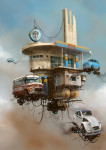
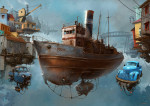





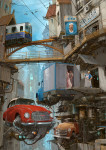


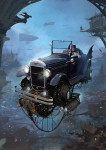




July 23, 2019
Art by Lukas Walzer. See more giant robot art here.
July 22, 2019
The world’s first openly Republican superhe- er… villain...
[image error]
The world’s first openly Republican superhe- er… villain. From the pages of Spider-man.
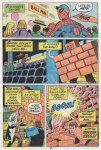
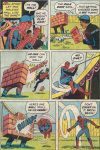
July 21, 2019
(Art) Fresh Insanity from Chrigel Farner
[image error]
Some new work by the ever-amazing German artist Chrigel Farner, previously featured on the blog.
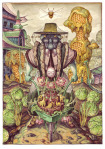
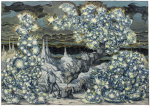
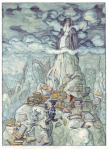
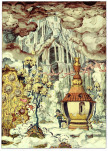
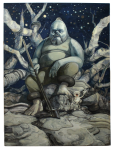
July 20, 2019
(Feature) Real-Life L.A. Noir
In 2000, boxes of photographs were discovered in a warehouse in Los Angeles. The pictures, which numbered in the thousands, were all taken in the line of duty by LAPD police officers between 1925 and the early 1970s. A selection of 80 are now on display at the city’s Lucie Foundation. This is the face of true noir, shot in glorious black and white.
My modern occult noir, FEAST OF SHADOWS, is now on sale.
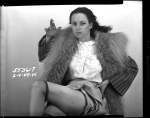
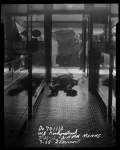
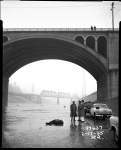
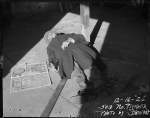

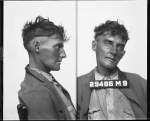


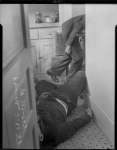
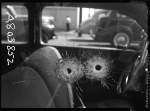

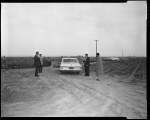
July 19, 2019
New Release Day!
[image error]
Last time I released a book was fall of 2017 — and that was just the collected omnibus edition of THE MINUS FACTION, the last novella having already been released the year before.
So, ya know, it’s kind of a big deal. It’s a day of celebration more than anything.
The book is here.
The blurb is:
Years ago, driven by greed, men penetrated the last soft places on earth. Out of the clear-cut jungle—out of nowhere—a man appeared, eyes rimmed in blue. The last shaman. A man who could make magic.
Now a recluse, known to modern society only as an eccentric chef, he is locked in an occult battle with an unseen nemesis. Their prize: a most unusual book, penned before the fall of Babylon, said to contain the recipe for eternal night.
Across five stories, five victims of inexplicable events narrate their encounters with an enigmatic titan of magic, a man without a past, whose tattooed palms hold the power to alter human history—or to end it.
Agony in Violet
As his marriage crumbles around him, a brilliant medical scientist searches for the source of a horrific illness that leaves its victims ashen and wasted. With no apparent connections between them, his only clues are the strange symbols that appear near the bodies after death. When a child is stricken, old traumas resurface and the good doctor turns in desperation to a curious consultant, who reveals that not every labyrinth has walls, and that the horrors you face there are always your own.
Curse of the Red Dagger
A troubled young woman, pregnant with a billionaire’s baby, disappears without a trace. Determined to save his child, he offers her best friend one million dollars to find her. But following in her friend’s footsteps proves more difficult than she expected. Everyone connected to the disappearance seems desperate to hide the truth. As they each fall to mysterious circumstances, death closes around her, and her only chance to save her friend is to sacrifice herself to an ancient power.
To the White of the Bone
A mangled body floats to the surface of a reservoir with nothing to distinguish the victim save for a binding knot branded under her tongue. The case is routed to the NYPD’s resident occultist, an uncompromising homicide detective whose history of unusual and uncertain results has left her career in shambles. Dodging an inquiry into a fatal shooting and pursued by a homicidal witch, she contemplates a devil’s bargain to stop the killer, who just may be the Lord of Shadows.
The Song on the Green
One by one, the children of an upscale Pennsylvania neighborhood are found crippled and catatonic, their minds seemingly vanished. As the panicked community searches in vain for a human predator, they neglect the only witness, an eight-year-old boy with a menagerie of strays, who is left to stand alone against the very creature that hunts him.
Bright Black
After carelessly killing an innocent, a beautiful aristocrat is cursed with eternal youth. Forced to endure as waves of friends and loved ones wither and fade around her, she wanders the ages in search of meaning—from the wars of Napoleon to the Victorians in India, from the Great Depression to the collapse of the Iron Curtain. Recruited as a spy in an occult war, she soon tires of blood and loss and retreats to a small village in the mountains, where an accident reveals missing memories and an unfortunate truth: that the mistakes of five lifetimes are not so easily fled.
Part urban fantasy, part hard-boiled whodunit, FEAST OF SHADOWS is a five-course occult mystery and the most devilish meal you’ll ever read.
The complete epic conundrum will be released in two parts.
art by Andoledius
A gallery of related images:
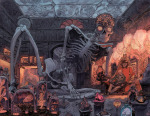
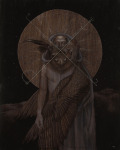
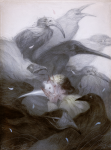
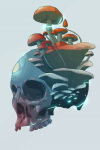
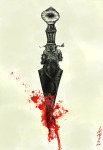



July 18, 2019
“I hate the assumption that you can’t write about something because you haven’t experienced it, and not just because it assumes a limit on the human imagination, which is basically limitless. It also suggests that some leaps of identification are impossibl
[image error]
July 17, 2019
Ruin of the Highest Order
[image error]
I designed a new seven-card tarot reading for the book. The order is depicted in the diagram below, which forms a kind of castle of the self.
Cards should be shuffled such that than can be drawn upright or in reverse.
The first position is the cardinal or cornerstone of the castle, also called the House of the World. It tells us about our overall personality.[image error]
The second position is the House of Water, which flows over the world. It is movement, activity, transition—our life goals and the unexpected changes we encounter.
The third position is the House of Life, which grows from the wet earth. This is the house of family, love, and relationships.
The fourth position is the House of Animals, which feed on the plants which sprout from the wet earth. This is our roving passion, our weakness, our foibles and limitations—which can also be our strengths.
The fifth position is the House of Man, both saint and sinner, who was given governance of the animals that eat the plants that sprout from the wet earth. This is our rational mind, our hobbies and activities. Work and career also fall here.
The sixth position, at the apex of the tower, is the House of the Devil, who keeps us from the divine. This represents our enemies—the friends that act against us—as well as the impediments and barriers to our own ascension.
The seventh and final position is the House of the Divine, of life and fortune—long or short, good or bad. It is not the future but rather what waits for us outside time, what may or may not come to be, depending on our actions. It is a caution and an encouragement.
The selection from the book below gives an example.
“Nearly 6:00,” I said to my strange companion. I tugged on the heavy locked doors again. “Pretty sure this guy has an office job. I say we give it a bit.”
We sat on the little stone block wall that lined the courtyard, just out of sight of the front door thanks to the tree in the middle of the space. My companion seemed especially pleased at that. He sat quietly, legs crossed, and admired it in silence, almost like the two of them were having a polite chat about life in the city and how warm it had gotten lately. After a few moments, he noticed me looking.
“What’s with the coat?” I asked.
Honest to God, he looked down like he didn’t even realize he was wearing it. He admired it for a moment.
“It belonged to one of your countrymen, a man named Zhang Jiao.”
“Oh? How’d you get him to part with it?”
“He’s been dead for the better part of two millennia.”
“No shit? That’s serious vintage.” I looked down at my shirt. “And here I thought my original ’70s Captain Caveman was cool. I’m surprised Beijing let you have it.”
“I doubt they are aware of its existence. It was a gift. From a man named Wu.”
A quiet moment passed and he turned back to the tree, as if it were a better conversationalist. Not to be outdone by the foliage, I asked him if he’d spent much time in China.
“I have been once or twice.”
“Oh yeah? Which is it? Once or twice?”
“It depends,” he said with a hint of impatience, “on whether or not you consider Tibet to be part of China. Tell me,” he added quickly, “is there a dragon?” He nodded to my side.
“How did you know about that?”
“Deduction. The dragon and the phoenix are the symbols of the emperor and empress, whose union begets the state, just as the union of yin and yang begets the universe.”
“No no no no. How did you know about my tattoo?”
“Ah. When you slept, you fell sideways on the sofa. Your shirt lifted some.” He pointed.
I eyed him.
“I replaced it,” he said.
“Uh huh.”
He motioned to my bag between us. “And that?”
I took out the tarot deck I’d gotten at Sour Candy. It was wrapped in plastic, all glossy and ridiculous. I ripped off the covering and read the 2D bar code on the back with my phone. While the app downloaded, he unfolded the little instruction manual stashed with the cards. It took him all of four seconds to scowl, crumple it, and add it to the trash trapped on the ground under the prickly bushes behind us.
“Excuse you,” I objected. “That wasn’t yours.”
He turned his lips down like he’d just drunk heavy bitters.
“Any idiot could invent a better system than any of those, and off the top of his head.”
“Any idiot, huh? Alright, Einstein.” I pulled the deck from the box and handed it to him. “Prove it.”
He gave a little annoyed sigh. Then he actually cracked his knuckles. It wasn’t until he started shuffling the deck that I noticed there weren’t any pictures on the cards.
“Wait.”
I pulled one just as he set the deck down for a third shuffle. There was a classic interlocking design on the back, and on the front, a 2D bar code on a white background with a simple border flourish around the edge. According to a note on the back of the box, it was a mechanism to prevent cheating. You had to draw a random card. You had no choice. They all looked the same, so there was no way to stack the deck to get the reading you wanted.
“That is your first card,” he said. “Set it down.”
The cards were crisp and they snapped loudly as he shuffled. He cut the deck once, shuffled twice more, then cut a second time, at which point he spread the cards on the flat surface between us and directed me to choose six more.
“But do not think,” he said.
“Yeah, yeah,” I objected. “I know.”
After I chose, he placed all seven cards in a kind of pyramid shape: three on the bottom, two in the middle, and one on top, with the final card floating above and to one side.
“The first position,” he explained, pointing to the bottom left, “is the cardinal, the cornerstone of the castle, also called the House of the World. It tells us something about ourselves, our overall personality.”
He directed me to turn it and I did so.
I had the option of using the classic Rider Waite deck or two alternate designs. There were also additional, fancier designs available for in-app purchase. I stuck with the default. I didn’t really have a choice.
I scanned the 2D code with my phone, and a picture of filled the screen.
The Moon.
The orb itself shone in full between two flanking towers. A dog and a wolf howled, while a lobster crawled from the water at the bottom.
“Ah,” he said. “You are a very creative person. Intuitive, as well.”
“That’s the nice way of telling someone they’re artsy and flaky, but thank you.”
He pointed at the cards. “In the first position, The Moon represents mystery, and all that follows will be its unraveling.”
He motioned to the middle card on the bottom row, and I turned it.
“The second position,” he said, “is the House of Water, which flows over the world. It is movement, activity, transition—our life goals and the unexpected changes we encounter.”
I scanned it with a beep.
The Knight of Wands.
A man in shabby chain armor rode an unsteady horse rising on its back legs. His right hand raised a rod sprouting green leaves.
“Impetuosity,” he said, “and the pursuit of a foolhardy adventure.”
“Okay,” I acknowledged grudgingly. “Fine. Two for two.”
“The third position,” he went on, “is the House of Life, which grows from the wet earth. This is the house of family, love, and relationships.”
With some hesitation, I took the third card and scanned it.
The Three of Swords.
A red heart was suspended in the air, pierced clean through by three crossing blades. Blood dripped from the bottom as rain fell from storm clouds in the distance.
“Heartbreak,” he said, “either yours or one caused by you.”
I flipped and scanned the next card without comment.
“The fourth position is the House of Animals, which feed on the plants which sprout from the wet earth. This is our roving passion, our weakness, our foibles and limitations—which can also be our strengths.”
The Tower. I set my phone down where he could see the screen.
Lightning fell from a black cloud and struck a stone tower, like a battlement, which shattered, sending the pair at the top, a man and a woman, tumbling to the ground.
“Ah,” he said. “Your foolhardy quest will end in tragedy, a ruin of the highest order.”
I frowned. When it was clear nothing else was forthcoming from me, he pointed to the second card on the second row.
“The fifth position is the House of Man, both saint and sinner, who was given governance of the animals that eat the plants that sprout from the wet earth. This is our rational mind, our hobbies and activities. Work and career also fall here.”
I turned the fifth card.
The Eight of Cups.
A lone figure dressed in a red hood and cape and carrying a walking stick followed the course of a river. The traveler moved away from the viewer, toward the dark and distant mountains, so it was impossible to say if it was a man or woman. An eclipsed sun hung in the sky, shining only as a thin halo around an otherwise black disc. A scatter of eight gold cups, all broken, lay in the foreground, as if they’d been smashed and discarded by the departing traveler.
“This symbolizes abandonment of old plans and aims,” he explained. Then he thought for a moment. “But given the prior house, I think it more likely means that magic has been used against you, driving you forth against your wishes and sending you on a journey that you would not have otherwise undertaken.”
I turned the sixth card, at the top of the pyramid.
“The sixth position, at the apex of the tower, is the House of the Devil,” he said “who yearns to replace the divine and who plagues all below. This represents our enemies—the friends that act against us—as well as the impediments and barriers to our own ascension.”
I scanned it. I paused when I saw it on the screen.
Death.
I looked at the image for a long moment. A skeletal figure in black armor rode a pale horse. Over the ground he dipped a long scythe, which mowed a garden of men, women, and children. A priest in a high hat knelt before him, hands pressed together in silent entreaty.
The chef could see the look on my face. “It may not be as you think. The Death card merely signifies an end, not necessarily the end of life.”
“How did you know what card it was?” I asked. I hadn’t turned the screen.
He didn’t answer.
“Why is the last card apart like that?” I asked.
The seventh and final card stood above and to the side of the others, like a sun rising over a castle. Or a moon, I guess.
“That is the House of the Divine, of life and fortune—long or short, good or bad. It is not the future but rather what waits for us outside time, what may or may not come to be, depending on our actions. It is a caution and an encouragement. You are female, so we draw in the converse position, the Sun, on the right.”
My eyes caught a scattered grouping of people approaching the building across the street. It happened every fifteen minutes or so—after each train. And there was Darren. Heading for the front door.
“Shit!”
I dropped the cards in my hand into my purse. I swiped the last and stuck it in my back pocket as the two of us trotted across the courtyard as nonchalantly as possible.
The book releases this Friday!
Here is a gallery of tarot art.















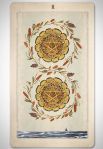








(Fiction) A Ruin of the Highest Order
[image error]
I designed a new seven-card tarot reading for the book. The order is depicted in the diagram below, which forms a kind of castle of the self.
Cards should be shuffled such that than can be drawn upright or in reverse.
The first position is the cardinal or cornerstone of the castle, also called the House of the World. It tells us about our overall personality.[image error]
The second position is the House of Water, which flows over the world. It is movement, activity, transition—our life goals and the unexpected changes we encounter.
The third position is the House of Life, which grows from the wet earth. This is the house of family, love, and relationships.
The fourth position is the House of Animals, which feed on the plants which sprout from the wet earth. This is our roving passion, our weakness, our foibles and limitations—which can also be our strengths.
The fifth position is the House of Man, both saint and sinner, who was given governance of the animals that eat the plants that sprout from the wet earth. This is our rational mind, our hobbies and activities. Work and career also fall here.
The sixth position, at the apex of the tower, is the House of the Devil, who keeps us from the divine. This represents our enemies—the friends that act against us—as well as the impediments and barriers to our own ascension.
The seventh and final position is the House of the Divine, of life and fortune—long or short, good or bad. It is not the future but rather what waits for us outside time, what may or may not come to be, depending on our actions. It is a caution and an encouragement.
The selection from the book below gives an example.
“Nearly 6:00,” I said to my strange companion. I tugged on the heavy locked doors again. “Pretty sure this guy has an office job. I say we give it a bit.”
We sat on the little stone block wall that lined the courtyard, just out of sight of the front door thanks to the tree in the middle of the space. My companion seemed especially pleased at that. He sat quietly, legs crossed, and admired it in silence, almost like the two of them were having a polite chat about life in the city and how warm it had gotten lately. After a few moments, he noticed me looking.
“What’s with the coat?” I asked.
Honest to God, he looked down like he didn’t even realize he was wearing it. He admired it for a moment.
“It belonged to one of your countrymen, a man named Zhang Jiao.”
“Oh? How’d you get him to part with it?”
“He’s been dead for the better part of two millennia.”
“No shit? That’s serious vintage.” I looked down at my shirt. “And here I thought my original ’70s Captain Caveman was cool. I’m surprised Beijing let you have it.”
“I doubt they are aware of its existence. It was a gift. From a man named Wu.”
A quiet moment passed and he turned back to the tree, as if it were a better conversationalist. Not to be outdone by the foliage, I asked him if he’d spent much time in China.
“I have been once or twice.”
“Oh yeah? Which is it? Once or twice?”
“It depends,” he said with a hint of impatience, “on whether or not you consider Tibet to be part of China. Tell me,” he added quickly, “is there a dragon?” He nodded to my side.
“How did you know about that?”
“Deduction. The dragon and the phoenix are the symbols of the emperor and empress, whose union begets the state, just as the union of yin and yang begets the universe.”
“No no no no. How did you know about my tattoo?”
“Ah. When you slept, you fell sideways on the sofa. Your shirt lifted some.” He pointed.
I eyed him.
“I replaced it,” he said.
“Uh huh.”
He motioned to my bag between us. “And that?”
I took out the tarot deck I’d gotten at Sour Candy. It was wrapped in plastic, all glossy and ridiculous. I ripped off the covering and read the 2D bar code on the back with my phone. While the app downloaded, he unfolded the little instruction manual stashed with the cards. It took him all of four seconds to scowl, crumple it, and add it to the trash trapped on the ground under the prickly bushes behind us.
“Excuse you,” I objected. “That wasn’t yours.”
He turned his lips down like he’d just drunk heavy bitters.
“Any idiot could invent a better system than any of those, and off the top of his head.”
“Any idiot, huh? Alright, Einstein.” I pulled the deck from the box and handed it to him. “Prove it.”
He gave a little annoyed sigh. Then he actually cracked his knuckles. It wasn’t until he started shuffling the deck that I noticed there weren’t any pictures on the cards.
“Wait.”
I pulled one just as he set the deck down for a third shuffle. There was a classic interlocking design on the back, and on the front, a 2D bar code on a white background with a simple border flourish around the edge. According to a note on the back of the box, it was a mechanism to prevent cheating. You had to draw a random card. You had no choice. They all looked the same, so there was no way to stack the deck to get the reading you wanted.
“That is your first card,” he said. “Set it down.”
The cards were crisp and they snapped loudly as he shuffled. He cut the deck once, shuffled twice more, then cut a second time, at which point he spread the cards on the flat surface between us and directed me to choose six more.
“But do not think,” he said.
“Yeah, yeah,” I objected. “I know.”
After I chose, he placed all seven cards in a kind of pyramid shape: three on the bottom, two in the middle, and one on top, with the final card floating above and to one side.
“The first position,” he explained, pointing to the bottom left, “is the cardinal, the cornerstone of the castle, also called the House of the World. It tells us something about ourselves, our overall personality.”
He directed me to turn it and I did so.
I had the option of using the classic Rider Waite deck or two alternate designs. There were also additional, fancier designs available for in-app purchase. I stuck with the default. I didn’t really have a choice.
I scanned the 2D code with my phone, and a picture of filled the screen.
The Moon.
The orb itself shone in full between two flanking towers. A dog and a wolf howled, while a lobster crawled from the water at the bottom.
“Ah,” he said. “You are a very creative person. Intuitive, as well.”
“That’s the nice way of telling someone they’re artsy and flaky, but thank you.”
He pointed at the cards. “In the first position, The Moon represents mystery, and all that follows will be its unraveling.”
He motioned to the middle card on the bottom row, and I turned it.
“The second position,” he said, “is the House of Water, which flows over the world. It is movement, activity, transition—our life goals and the unexpected changes we encounter.”
I scanned it with a beep.
The Knight of Wands.
A man in shabby chain armor rode an unsteady horse rising on its back legs. His right hand raised a rod sprouting green leaves.
“Impetuosity,” he said, “and the pursuit of a foolhardy adventure.”
“Okay,” I acknowledged grudgingly. “Fine. Two for two.”
“The third position,” he went on, “is the House of Life, which grows from the wet earth. This is the house of family, love, and relationships.”
With some hesitation, I took the third card and scanned it.
The Three of Swords.
A red heart was suspended in the air, pierced clean through by three crossing blades. Blood dripped from the bottom as rain fell from storm clouds in the distance.
“Heartbreak,” he said, “either yours or one caused by you.”
I flipped and scanned the next card without comment.
“The fourth position is the House of Animals, which feed on the plants which sprout from the wet earth. This is our roving passion, our weakness, our foibles and limitations—which can also be our strengths.”
The Tower. I set my phone down where he could see the screen.
Lightning fell from a black cloud and struck a stone tower, like a battlement, which shattered, sending the pair at the top, a man and a woman, tumbling to the ground.
“Ah,” he said. “Your foolhardy quest will end in tragedy, a ruin of the highest order.”
I frowned. When it was clear nothing else was forthcoming from me, he pointed to the second card on the second row.
“The fifth position is the House of Man, both saint and sinner, who was given governance of the animals that eat the plants that sprout from the wet earth. This is our rational mind, our hobbies and activities. Work and career also fall here.”
I turned the fifth card.
The Eight of Cups.
A lone figure dressed in a red hood and cape and carrying a walking stick followed the course of a river. The traveler moved away from the viewer, toward the dark and distant mountains, so it was impossible to say if it was a man or woman. An eclipsed sun hung in the sky, shining only as a thin halo around an otherwise black disc. A scatter of eight gold cups, all broken, lay in the foreground, as if they’d been smashed and discarded by the departing traveler.
“This symbolizes abandonment of old plans and aims,” he explained. Then he thought for a moment. “But given the prior house, I think it more likely means that magic has been used against you, driving you forth against your wishes and sending you on a journey that you would not have otherwise undertaken.”
I turned the sixth card, at the top of the pyramid.
“The sixth position, at the apex of the tower, is the House of the Devil,” he said “who yearns to replace the divine and who plagues all below. This represents our enemies—the friends that act against us—as well as the impediments and barriers to our own ascension.”
I scanned it. I paused when I saw it on the screen.
Death.
I looked at the image for a long moment. A skeletal figure in black armor rode a pale horse. Over the ground he dipped a long scythe, which mowed a garden of men, women, and children. A priest in a high hat knelt before him, hands pressed together in silent entreaty.
The chef could see the look on my face. “It may not be as you think. The Death card merely signifies an end, not necessarily the end of life.”
“How did you know what card it was?” I asked. I hadn’t turned the screen.
He didn’t answer.
“Why is the last card apart like that?” I asked.
The seventh and final card stood above and to the side of the others, like a sun rising over a castle. Or a moon, I guess.
“That is the House of the Divine, of life and fortune—long or short, good or bad. It is not the future but rather what waits for us outside time, what may or may not come to be, depending on our actions. It is a caution and an encouragement. You are female, so we draw in the converse position, the Sun, on the right.”
My eyes caught a scattered grouping of people approaching the building across the street. It happened every fifteen minutes or so—after each train. And there was Darren. Heading for the front door.
“Shit!”
I dropped the cards in my hand into my purse. I swiped the last and stuck it in my back pocket as the two of us trotted across the courtyard as nonchalantly as possible.
The book releases this Friday!
Here is a gallery of tarot art.



























